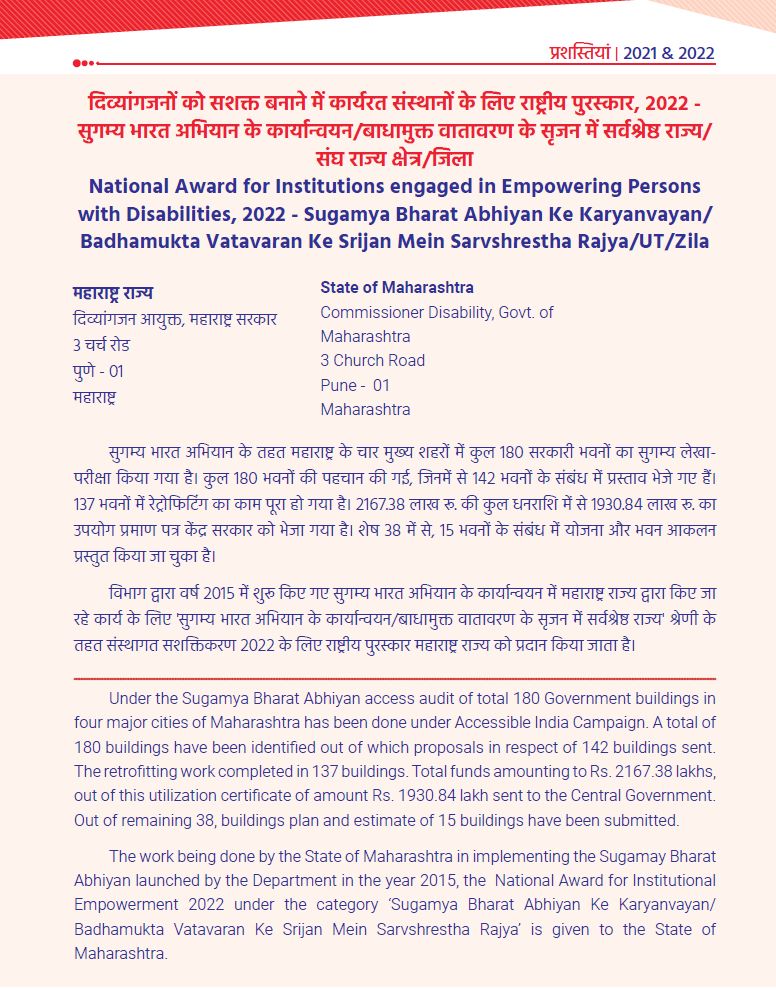Ministry of Social Justice & Empowerment
Making Buildings Accessible for Divyang Jan: Maharashtra receives National Award for Institutional Empowerment 2022 under category Badhamukta Vatavaran Ke Srijan Mein Sarvshrestha Rajya Award
प्रविष्टि तिथि:
03 DEC 2022 9:10PM by PIB Mumbai
New Delhi / Mumbai, December 3, 2022
We know that an important component of empowering Persons with Disabilities or Divyang Jan is to make our physical environments accessible to them. An accessible physical environment benefits everyone, not just persons with disabilities. Under the Accessible India Campaign, it is envisaged that measures be undertaken to eliminate obstacles and barriers to indoor and outdoor facilities including schools, medical facilities, and workplaces. These would include not only buildings, but also footpaths, curb cuts, and obstacles that block the flow of pedestrian traffic.
As we celebrate International Day of Persons with Disabilities today, the state of Maharashtra has been recognized for the way it has been implementing Sugamay Bharat Abhiyan. The state has received the National Award for Institutional Empowerment 2022 under the category ‘Sugamya Bharat Abhiyan Ke Karyanvayan / Badhamukta Vatavaran Ke Srijan Mein Sarvshrestha Rajya’, at a function to celebrate “International Day of Persons with Disabilities”, held in New Delhi today.
So, what has the state done in order to have been chosen for this distinction? Under the Sugamya Bharat Abhiyan, the state has done access audit of a total of 180 Government buildings in four major cities of Maharashtra.

Out of these 180 buildings, proposals for making 142 buildings accessible have been sent. The retrofitting work has been completed in 137 buildings. Out of funds amounting to Rs. 21.67 crore, utilization certificate for Rs. 19.30 crore has been sent to the Central Government.
Out of remaining 38 buildings, the building plan and estimate for 15 buildings has been submitted.
An accessible government building is one, where persons with disabilities have no barrier in entering it and using all the facilities therein. This covers the built environment – services, steps and ramps, corridors, entry gates, emergency exits, parking – as well as indoor and outdoor facilities including lighting, signages, alarm systems and toilets.
Identifying accessible buildings requires annual accessibility audits that determine if a building meets agreed-upon standards. Once a building is deemed fully accessible, an annual audit is not necessary, but should be required for any proposed changes to the structure or systems contained therein. A full audit can then be done on a less frequent basis.
Standards of accessibility should be as consistent as possible with international standards, such as those of the ISO, taking into account the local context. In regards to the built environment, ISO 21542:2011, Building Construction – Accessibility and Usability of the Built Environment, delineates a set of requirements and recommendations concerning construction, assembly, components and fittings.
***
PIB MUMBAI | Dheep / Sriyanka/ Parshuram
Follow us on social media:  @PIBMumbai
@PIBMumbai  /PIBMumbai
/PIBMumbai  /pibmumbai
/pibmumbai  pibmumbai[at]gmail[dot]com
pibmumbai[at]gmail[dot]com
(रिलीज़ आईडी: 1880737)
आगंतुक पटल : 2099